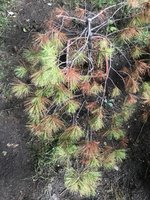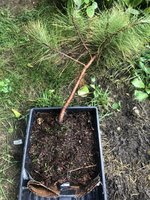dinchigren
Seedling
Hello,
New to Pine Bonsai to the degree that I am not sure about species I collected about 5 weeks ago. I have collected them (yamadori) in Maine and put them in pots in my garden in Boston mid June, 2021.
Right now, about 5 weeks later, two of them show some brown needles. Those are pines in first two photos and I assume that is White Japanese pine. Anything I can do to help them survive?
I tried to collect as much roots as possible and put them in shallow pots with Premium bonsai soil while keeping about 30% of original soil. They are collected close to the lake. I keep them out of direct sun. I would appreciate any tips.
Pine in the last photo is Black pine, I think. That one is doing just fine. That one I have treated the same except that I have not use Bonsai soil but just ordinary soil with 30% of original soil. Not sure it that matters. In everything else they were treated the same.
Thanks in advance and thanks for opportunity to ask questions on this forum.
New to Pine Bonsai to the degree that I am not sure about species I collected about 5 weeks ago. I have collected them (yamadori) in Maine and put them in pots in my garden in Boston mid June, 2021.
Right now, about 5 weeks later, two of them show some brown needles. Those are pines in first two photos and I assume that is White Japanese pine. Anything I can do to help them survive?
I tried to collect as much roots as possible and put them in shallow pots with Premium bonsai soil while keeping about 30% of original soil. They are collected close to the lake. I keep them out of direct sun. I would appreciate any tips.
Pine in the last photo is Black pine, I think. That one is doing just fine. That one I have treated the same except that I have not use Bonsai soil but just ordinary soil with 30% of original soil. Not sure it that matters. In everything else they were treated the same.
Thanks in advance and thanks for opportunity to ask questions on this forum.



